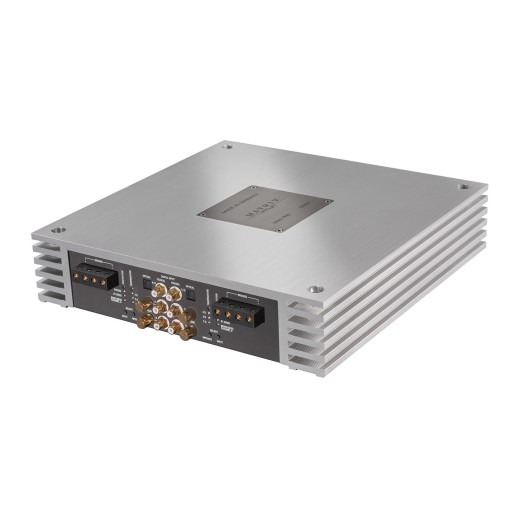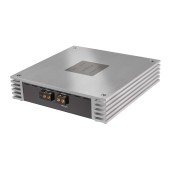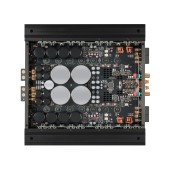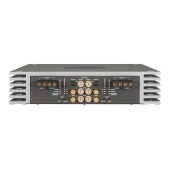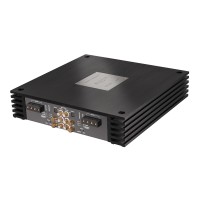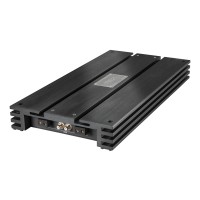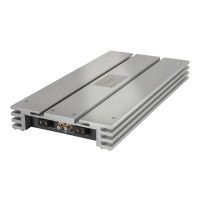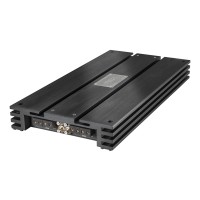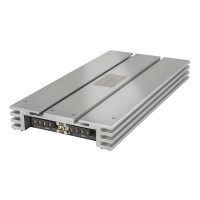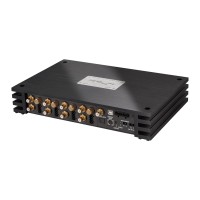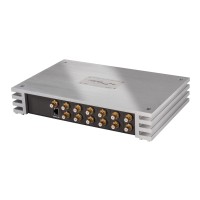Brax MX 4 Pro Silver amplifier
More about the product
- Use our consulting room
- You can return the goods to us within 14 days
- Try the product at our store
Brax MX 4 Pro Silver amplifier
Is it possible to make the best car amplifier in the world even better? When Brax started developing the MX4 PRO, it was a real challenge for their engineers. When designing a BRAX product, it is essential to consider and optimize every single detail over and over again, even if it seems less important at first glance. It is the only approach to push the acoustic and technical limits further and further. This masterpiece is a perfect symbiosis of state-of-the-art components and ingenious technological improvements, without neglecting the heritage and tradition of the brand that BRAX is famous for. As the only manufacturer still at Brax, they take for granted the hand-selection of power transistors for the production of each BRAX amplifier, and it's no secret that the necessary tools and instruments for this selection are in-house developed. This unique process not only ensures the lowest possible series tolerances, but also unmatched measurement and performance data.
A significant proportion of the overall performance is based on the extensive effort put into powering all the modules inside our amplifiers. Separate and stabilized supply voltages for each of the two channels guarantee perfect conditions for each amplification stage. Meanwhile, the ultra-low ESR electrolytic capacitors (specially made for Audiotec Fischer) are as legendary as our encapsulated toroidal power transformers, rated at over 1,800 watts. A completely redesigned circuit board design with four solid copper layers in total ensures maximum current flow - so it's no wonder the MX4 PRO 4 x 300 RMS into 4/2/1 Ohms delivers more power to the speaker terminals than ever before.
But that's not enough - the MX4 PRO is also a paradigm for bridging the gap between traditional amplifier technology and the digital era. As a first for the car audio segment, the volume adjustment in combination with BRAX DSP takes place just before the output stages that drive the speakers – needless to say, this is done in the analog domain without sacrificing any signal resolution. The BRAX DSP embeds the volume information into the SPDIF digital data stream, which is then decoded inside the MX4 PRO. This aspect alone demonstrates the BRAX engineers' pursuit of pure perfection - and please be assured that this care will continue throughout the manufacturing process. Each individual amplifier is made to order and its respective serial number is recorded in the database. That's why every BRAX MX4 PRO is a rare, unique product that rightfully deserves the label "high-end made in Germany".
The main features of the amplifier Brax MX 4 Pro amplifier
- Two digital stereo digital inputs in SPDIF format (optical and electrical) with a sampling frequency of up to 192 kHz.
- DiSAC (Digital Signal Analog Controlled) volume control for digital signal inputs, controllable via BRAX DSP.
- Optimized four-layer PCB design for maximum power and signal flow and increased output power.
- Lossless switching of input signals via relays with gold-plated contacts.
- The best possible impulse response thanks to the abstinence of coupling capacitors in the signal path.
- Incredible damping factor of over 1400 @ 4 Ohms for perfect speaker control.
- Maximized signal-to-noise ratio thanks to power synchronization.
- Extremely complex and regulated switching power supply.
- Eight-pin capacitors with a total capacity of 40,000 μF and the lowest possible ESR, as well as a 300 A suppressor choke to smooth out peak supply currents.
- Separate connector for BRAX power stabilizer.
- Loudspeaker protection circuit through sophisticated high current power relays.
- Specially designed toroidal transformers made from highly permeable core materials for the highest possible saturation currents.
- 32 hand-selected top-of-the-line MOSFETs for tightest tolerances and excellent measured data.
- Engraved serial number on stainless plate.
- Impedance-independent output power of 300 W RMS per channel.
- Stable 4, 2 and 1 Ohm.
- Processor and temperature-controlled fan on the bottom plate.
- Massive cooler made of a special aluminum alloy for optimal cooling of all power transistors.
| Catalog number | BRAX MX 4 PRO SILVER |
| Brand | Brax |
| Links | Official web presentation |
| Number of amplifier channelsAmplifiers are divided into: - Monoblocks - 2-channel - 3-channel - 4-channel - 5-channel - 6-channel - multi-channel Each channel is used to power one speaker for the coaxial type, or one side if they are component speakers. Monoblock type amplifiers are mainly used for subwoofers. 2-channel are suitable for both subwoofers and, for example, the front pair of speakers in a car. 3-channel is used for front or rear speakers + subwoofer. 4-channel are used for front + rear speakers or 1 pair of speakers + subwoofer. 6 or 5-channel are used for 2 pairs of speakers + subwoofer, most often. Bridging means connecting the amplifier to a bridge, using the + pole from one channel and the - pole from the other channel. In most cases this is shown as "BRIDGED" on the amplifier. | 4 |
| Energy class of the amplifierAmplifiers are divided into two basic classes: analog and digital . Analog amplifiers (A/B) have higher consumption requirements, but usually have a more natural sound. Digital amplifiers (D) have significantly lower consumption and higher efficiency, but the sound may not be as faithful as with classic analog amplifiers. | A/B |
| RMS power into 4 ΩRMS power when loading speakers or subwoofer at 4 Ω. RMS power is the constant power of the amplifier and is one of the most important parameters when choosing an amplifier. | 4 x 300 / 2 x 600 W |
| RMS power into 2 ΩRMS power when loading speakers or subwoofer at 2 Ω. RMS power is the constant power of the amplifier and is one of the most important parameters when choosing an amplifier. | 4 x 300 / 2 x 600 W |
| RMS power into 1 ΩRMS power when the subwoofer is loaded at 1 Ω. RMS power is the constant power of the amplifier and is one of the most important parameters when choosing an amplifier. When connected to 1 Ω, significant heating of the amplifier may occur. | 4 x 300 W |
| Inputs | 4 x RCA, 2 x SPDIF optický, 2 x SPDIF koaxiální |
| Outputs | 4 x reproduktorový |
| Frequency rangeThe ability of the amplifier to reproduce the signal from the lowest frequency to the highest = faithfully reproduce the sound in a specific frequency band. Professionally: In the frequency range from 40 to 16,000 Hz, the vast majority of fundamental and overtones (harmonics) of all musical instruments are found. We are interested in the course of the radiated sound pressure in this range of frequencies when the loudspeaker system is supplied with constant power. We call this course the frequency characteristic, which tells us the level of radiated sound pressure in decibels (dB) depending on the frequency. The frequency characteristic of a speaker or speaker system can be expressed most succinctly with a graph. Mostly, however, the frequency characteristic is indicated by indicating the maximum tolerance of the sound pressure in the given frequency range, e.g. 50 to 15,000 Hz -+ 6 dB. Since the frequency characteristics of loudspeakers and systems in general are quite uneven, some manufacturers do not even specify this maximum tolerance of sound pressure in decibels in their catalogs for reasons of prestige. Data impoverished in this way is unfortunately worthless. What is valid is that the manufacturer offers a speaker system with a frequency range of 30 to 20,000 Hz, if he is worried about stating the maximum unevenness of the sound pressure in this range, because he can have a tolerance of, for example, +- 20 dB. The unevenness or undulation of the frequency curve in good speaker systems for high-quality music performance should not exceed +-3 dB in the 80 to 12,000 Hz band and +-6 dB in the 40 to 16,000 Hz band. Greater unevenness already depletes or emphasizes certain tonal areas, which can cause audible or even disturbing distortion. The proportion between fundamental tones and higher harmonics also changes, thereby changing the color of the sound, and individual musical instruments as well as the entire musical image sound unnatural. | 10 - 80000 Hz |
| Harmonic Distortion (THD)Total harmonic distortion indicates how much the input signal is distorted in the amplifier. Distortions appear as overtones contained in the output signal. The proportion of originally absent parts of the signal is given as a percentage, typical values are between 0.001% and 0.5%. Distortion is measured in their power band. If it exceeds the limit of 0.7% from a certain power, it is the value of the output power of the given amplifier, from which it no longer plays without distortion and from which the distortion usually increases steeply, so that no further increase in power can be counted on. The lower the value, the better. | < 0.0005 % |
| Signal-to-noise ratioThe signal-to-noise ratio means that the output signal always contains noise. The signal-to-noise ratio expresses how much of this noise is compared to the useful signal. The so-called A value is given, which does not take deep and very high frequencies into account. This corresponds to the characteristic of human hearing, which is not so sensitive to deep frequencies, especially below 1 kHz. The higher the value, the better the amplifier is. | > 116 dB |
| Input sensitivityIn order for the amplifier to perform its function correctly, it requires an input signal of a certain level, which is different for car radios. It is measured in "Volts" (e.g. 2 V, 4 V, etc.) The higher the value at the output of the pre-amplifier, or car radio, the less demands are placed on the power of the amplifier. However, the amplifier must allow this input sensitivity, and for that reason this value is also given for the amplifier. | 1 - 8 V |
| Damping factorDF - Damping Factor . It is the ratio of the load (repro + cables, crossover, etc.) to the internal resistance of the amplifier. The bigger the DF, the more controlled the bass. Amplifiers with a lower DF tend to hum. Subwoofers with a higher Q in the bass reflex and sometimes in the enclosure will also cause humming. | > 1400 |
| The value of the fuses on the amplifierFrom the value of the fuses on the amplifier, you can get a true picture of the real performance of the amplifier. | 6 x 25 A |
| Dimensions of the amplifier | 79 x 360 x 360 mm |
| Mass | 12 Kg |

